National Liberation Front, 5th Anniversary of Republic of South Vietnam, June 6th, 1974, Michel Nr. NLF 44-49; Six stamps all in 10 Dong nominals were issued in perforation 11.0. These were the first stamps that were issued in the currency of the South Vietnamese Regime.
Ta Phi Long writes in his book „Some Features of Postal History in the period of Revolutionary South Vietnam”: “Since 1972-1973 the Liberation Army had completely occupied and controlled some areas in Quang Tri Province, since then they were officially founded (SIC) some of the first post offices and began operations. They structured these post offices from district level upwards (or town) with their own postmarks bearing the name DISTRICT (SIC) of the post office and always have the words “MN-VIET NAM” at the bottom.” He also states that the first such post office was located in Dong Ha. Since all the monetary transactions in the South were handled using South Vietnamese Dong it was decided that the new stamps should also be denominated in that currency.
According to Ta Phi Long’s book the stamps issued under the banner of “The National Liberation Front of South Vietnam (NLF)” and its successor organization “The Provisional Revolutionary Government of the Republic of South Vietnam (PRGRSV)” were intended to be used in liberated areas of the South that were in a disputed state to replace the stamps of the old Saigon regime and as a political propaganda tool to assist the NFL and PRGRSV in furthering the reputation and influence of both organizations internationally.
In reality there is no evidence that the editor has seen so far, that these stamps saw any genuine postal prior to the “Fall of Saigon” on April 30th, 1975. All samples on cover that pre-date “Liberation” are either philatelically inspired (some sent in contravention of postal regulations from North Vietnam, where these stamps were not valid) or are favor cancels that simply have been back-dated after the war (as evidenced by lacking routing and arrival cancels). One can clearly see postal use after “Liberation” in either the un-overprinted or overprinted version of the stamps but even then, genuine samples are not common. So, while some collectors may write these issues off purely as propaganda vignettes that were primarily sold for the purposes of gaining hard currency, they nevertheless are part of Vietnamese postal history, but just found very limited actual use.
In January of 1975 the North Vietnamese started a new offensive to liberate the South. According to Ta Phi Long’s book the following places were liberated from January to May of 1975:
Phuoc Long (January 6th, 1975)
Buon Me Thuot (March 11th, 1975)
Kon Tum (March 17th, 1975)
Pleiku (March 18th, 1975)
Quang Tri (March 19th, 1975)
Binh Long (March 20th, 1975)
Hue (March 26th, 1975)
Da Nang (March 29th, 1975)
Binh Dinh (April 1st, 1975)
Nha Trang (April 2nd, 1975)
Phan Rang (April 16th, 1975)
Binh Thuan (April 19th, 1975)
Xuan Loc (April 21st, 1975)
Saigon (April 30th, 1975)
Tay Ninh (April 30th, 1975)
Can Tho (May 1st, 1975)
Vinh Long (May 1st, 1975)
Genuine usage of NLF stamps would have to have occurred on or after the liberation date but again, no postally used samples have been seen by the editor so far.
The Anniversary
Part of this effort was a series of six stamps issued on June 6th of 1974 in celebration of the 5th Anniversary of Proclamation of the Republic of South Vietnam. The denomination was 10 South Vietnamese Dong each, the currency of the Republic of Vietnam. This may seem strange to some, but using South Vietnamese Dong made sense for the PRGRSV, as it was the currency actually in use in the South at that time. In the SICP Journal Volume X, Nr. 3 from May of 1980 Gregor Schwirtz stated:
At the beginning of April 1975 postal communications were resumed in the Da Nang-Hoi An-Tam Ky region – and the postal charge for a letter within this area was fixed at 15 dong, probably on the basis of the earlier Saigon postal rates. Later on, denominations of 25 dong were used. As only dong stamps were available, overprints in 15 and 25 dong were made in this region and later confirmed by the DaNang post office..After the fall of Saigon, a uniform rate of 30 dong for a normal letter was fixed for the entire country. As the earlier 10 dong were too low in value, various types of overprints in 30 dong were produced in Da Nang.
So, the nominal of 10 Dong of this set did not make any sense in 1975 any longer. The standard letter rate in the South at that time was already 15 to 25 Dong and an increase to 30 Dong was planned for the middle of 1975 so, if the PRGRSV had hoped that these stamps would actually serve for their intended purpose to eventually replace the stamps of the Republic of Vietnam, they would have used a more useful nominal of 25 or 30 Dong instead. So again, the emission of these stamps had more of a propaganda and revenue goal than actual postal usage.
Five of the stamps were printed in se-tenant strips, two strips, side by side, in each row (Exhibit 1). Each sheet featured ten rows for a total of 20 strips. One sixth stamp was printed by itself in sheets of 100.
Here is the mint set minus the separately printed 10D stamp.
Here is a pair of the separately printed 10D stamps.
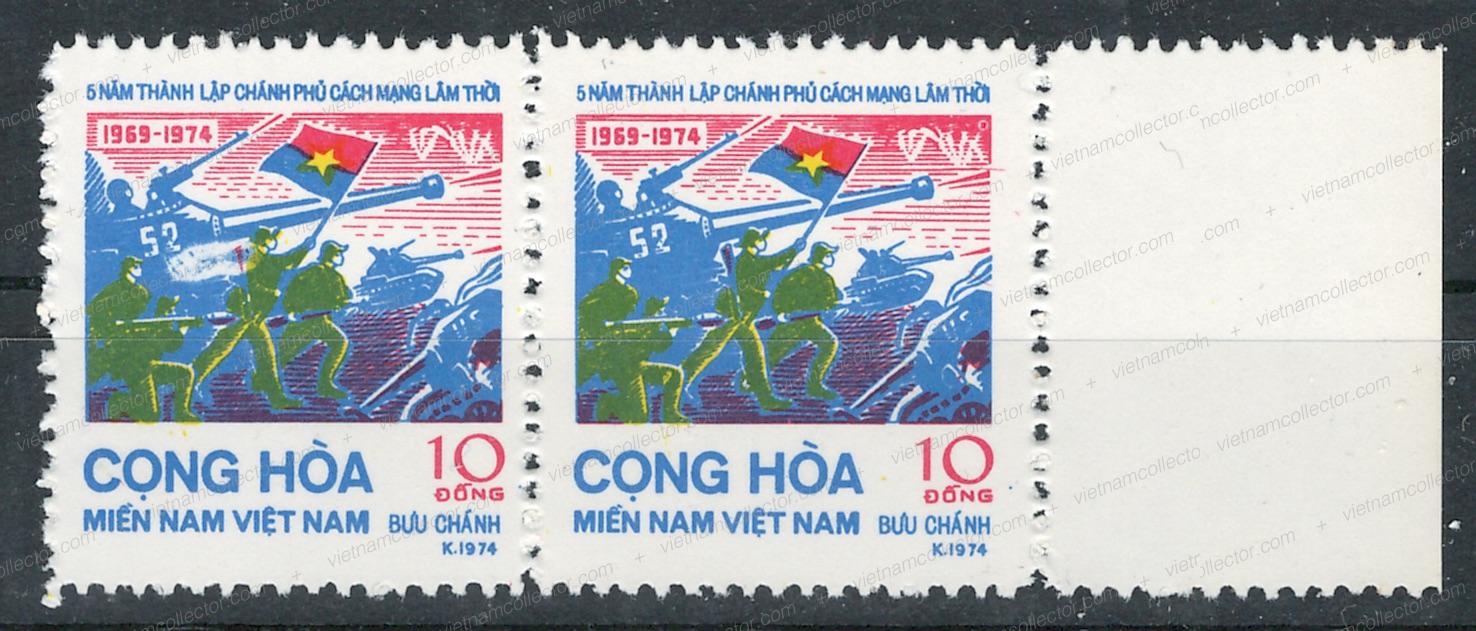
Here is the cancelled to order set.
Error
There is a well documented error on the strips on a partial printing on the second stamp from the left, depicting a “demonstration”. On the error stamp the right lower red flag is missing and all one can see is a white space instead (Exhibit 2). This error apparently appeared multiple times in this particular printing in each sheet as the attached two rows of three stamps demonstrate (Exhibit 3). Witness that both stamps in the center show the missing flag error. The author has yet to see a complete sheet with the red flag missing error, so it is not clear if the error appears on every “demonstration” stamp in the sheet or only on some. What is known, is, that the error is not very hard to find. While, of course, the majority of specimens do not show any error, the misprint can usually be bought for under $10 on E-Bay, so clearly, it is not very rare. Michel list it in mint and used condition at €30.
Detailed scan of the affected area:
These stamps were reportedly printed in the off-set method. This means areas with color are defined by applying a design shaped photo polymer that attracts printing color while areas that were to remain “white” are wetted with water which will reject it. Given, that the error appears multiple times in a sheet indicates that it was already incurred during the preparation of the original set-tenant clichés and was then later simply replicated by copying the original cliché to prepare the final cylinder of 20 strips in total. It is therefore likely that the error appears 20 times in each error sheet.
Detailed scan of the affected area:
Another piece in the puzzle
Another piece in the puzzle appeared recently on the market. A well known Vietnamese E-Bay vendor offered an error strip that until then had not been seen at all in the market. It missed all of the red color, save for the lower right flag on the “demonstration” stamp (Exhibit 4). Since it took over 40 years since initial printing for this second error to appear and the fact that it was not even contained in the highly specialized and gold medal honored collection of Tran Trong Khai on the subject of NFL and PRGRSV, the second error must be extremely rare. However, given the sheet size, at least 20 strips with most red color omitted should have been printed. Recently well known Vietnamese philatelist Lucan Lu confirmed that only one sheet of 20 strips is in existence.
Since each color phase is printed by using a separate printing plate, it is rather weird that this issue has produced two errors both which showed a lack of color in the red printing phase. This would suggest that printing of the red color did not occur in a single print run but in two separate runs. Now, this is not exactly economically efficient and would have therefore been a work-around to correct a known deficiency. It is therefore not far fetched to speculate that the missing “red flag” error, once discovered, would have been corrected by running all the unissued error sheets through a second red print stage that only applied the missing flag. Only this would explan the occurrence of both errors.
Another plate error is known on a partial printing of this issue. In it the red “0” of the nominal “10” is broken at the top right (top left stamp).
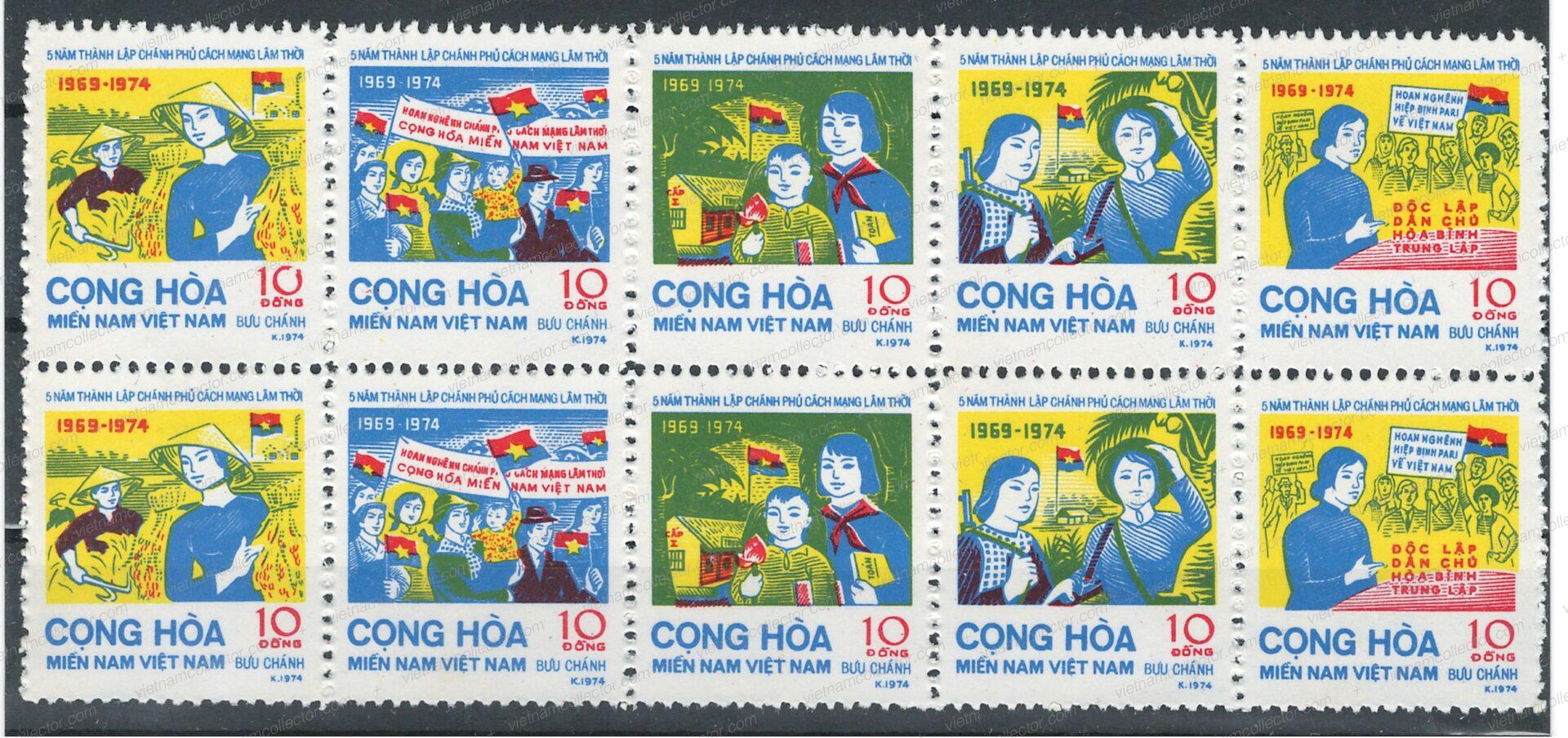
Details of the affected area:
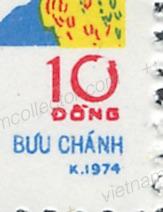
Given that this issue was printed in the National Printing House in Hanoi, one can also find the occasional printing flaw. Witness the uneven color application on stamps 2 and 3 from the left (Exhibit 5) which leave the blue and dark green color applied rather blotchy. This can occur when the polymer that is supposed to pick up a particular color is worn and no longer picks up color for the full design. This type of printing flaws will never be featured in a catalogue but they nevertheless tend to “spice up” a collection, so watch out for them.

Detailed scan of the affected area.

If you have any other information or ideas regarding these errors please write to the editor .
After the fall of Saigon on April 30th, 1975 the post office was closed for a number of days in order to allow the new administration to set up. The post office in Saigon reopened officially on May 7th, 1975, the day when the 10D and 20D Ho Chi Minh among soldier set was released. Given that most South Vietnamese were laying low, not knowing what to expect from the new Government, very few letters were actually processed on that day. Here is a rare philatelic letter commemorating the re-opening of the post office cancelled on May 7th, 1975 with the Saigon cancel to which “M.N.” (Mien Nam) and two stars were added.
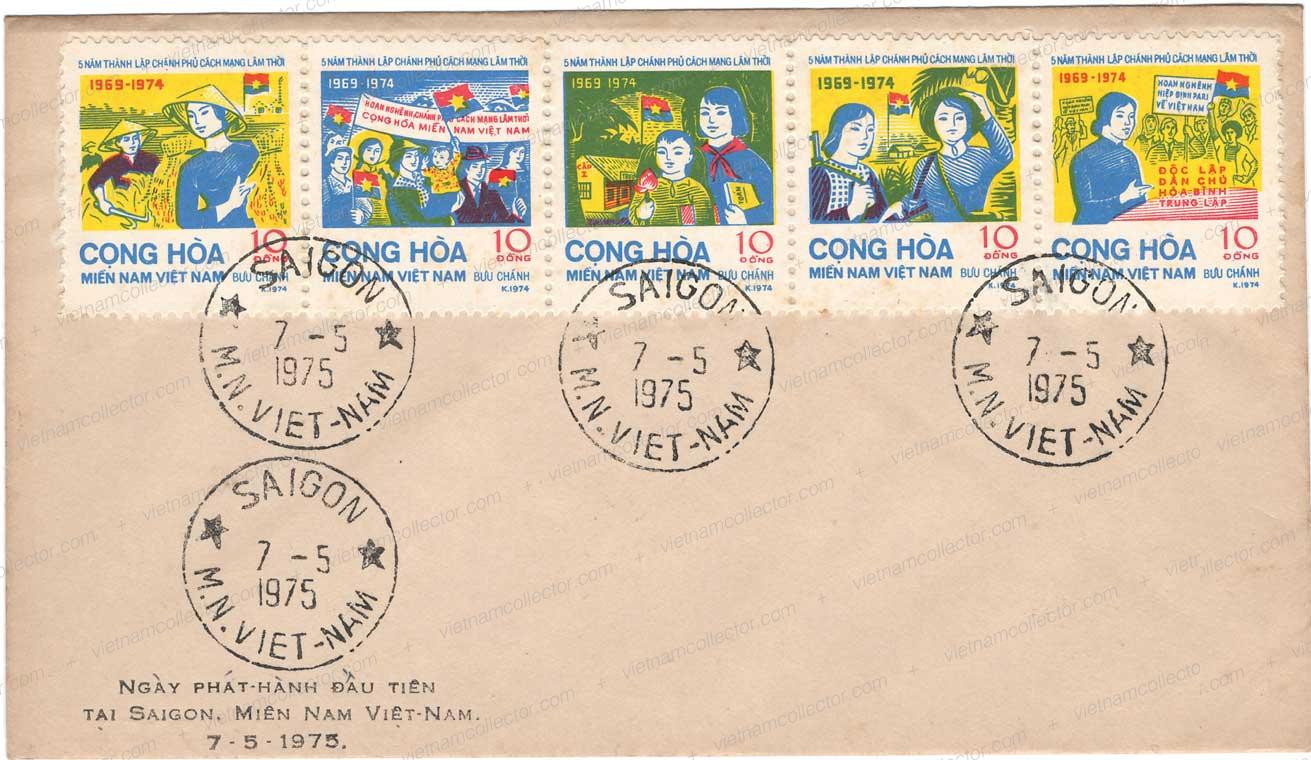
However, the next day philatelist did show up at the post office to get some blank envelopes cancelled with NLF stamps. Here is an envelope that features a number of NLF stamps cancelled with the new “M.N.” Saigon cancel.
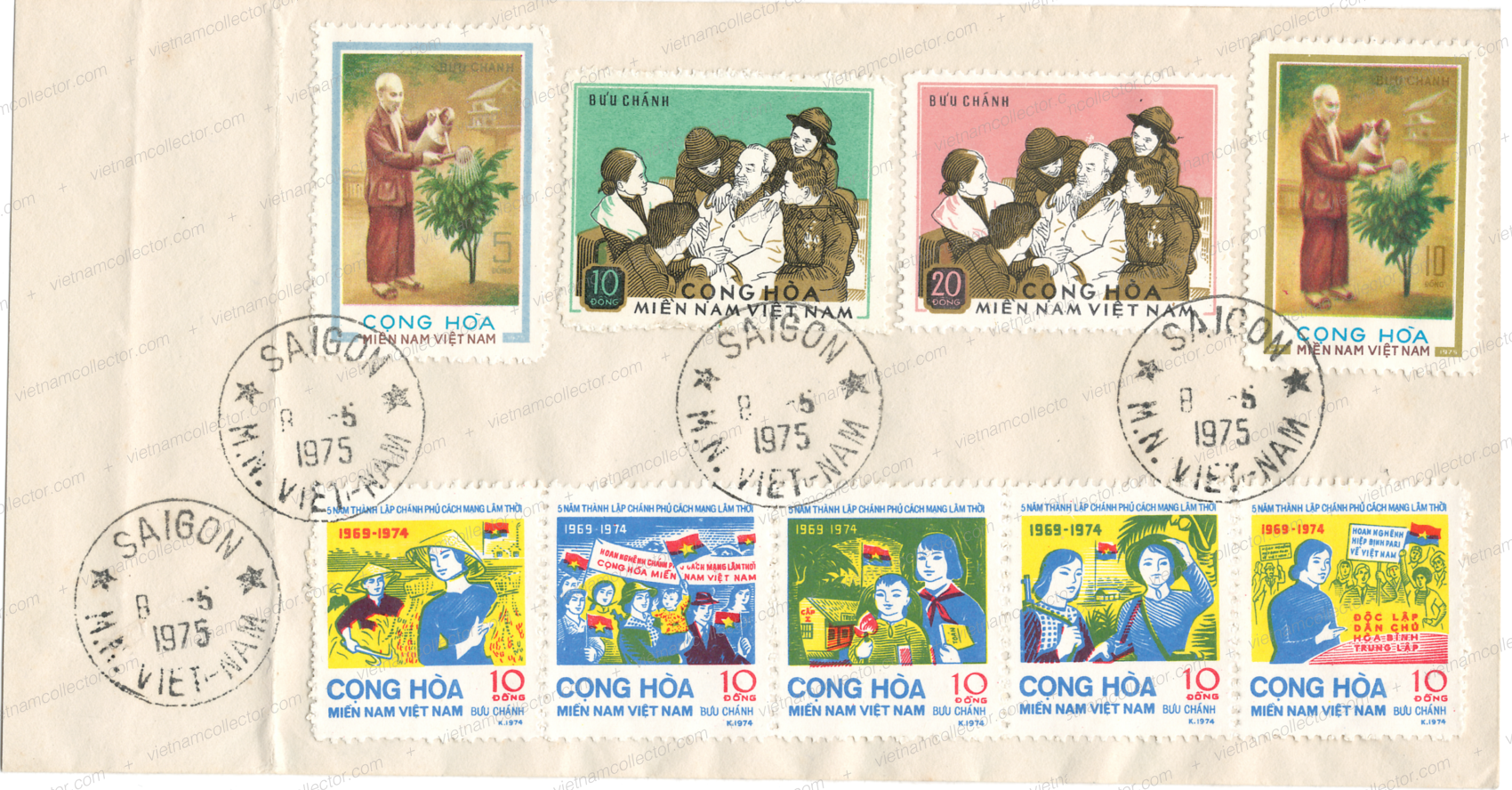
On occasion of Ho Chi Minh’s 85th Birthday (May 19th, 1975) a special memorial cancel was used to cancel NLF stamps that had been issued prior to this date.
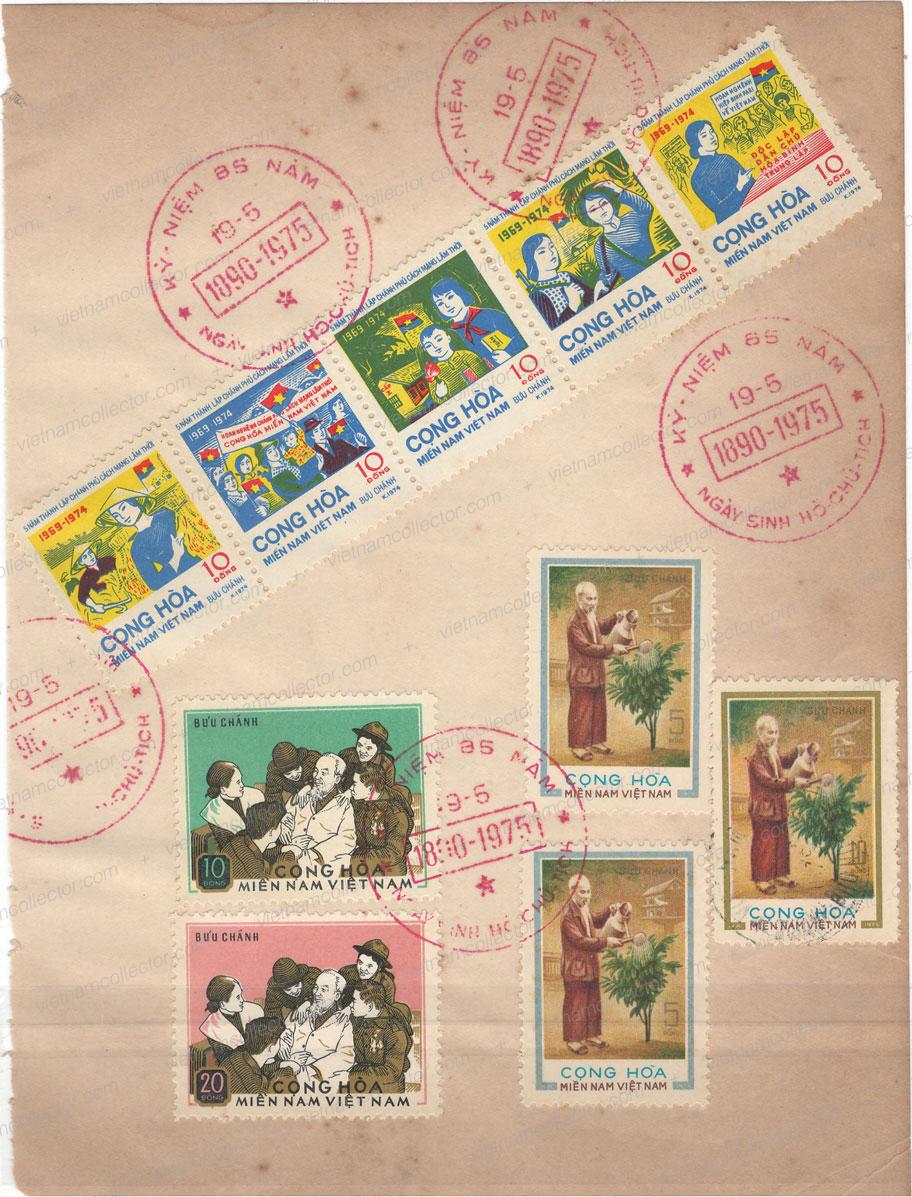
Large letter fragment featuring two of the 10D stamps paying the 20D standard letter rate that was in force in the South at that time and sent from Can-Tho on June 2nd, 1975 to Saigon. Note that Can-Tho was still using the cancel of the old regime without the M.N. insert.
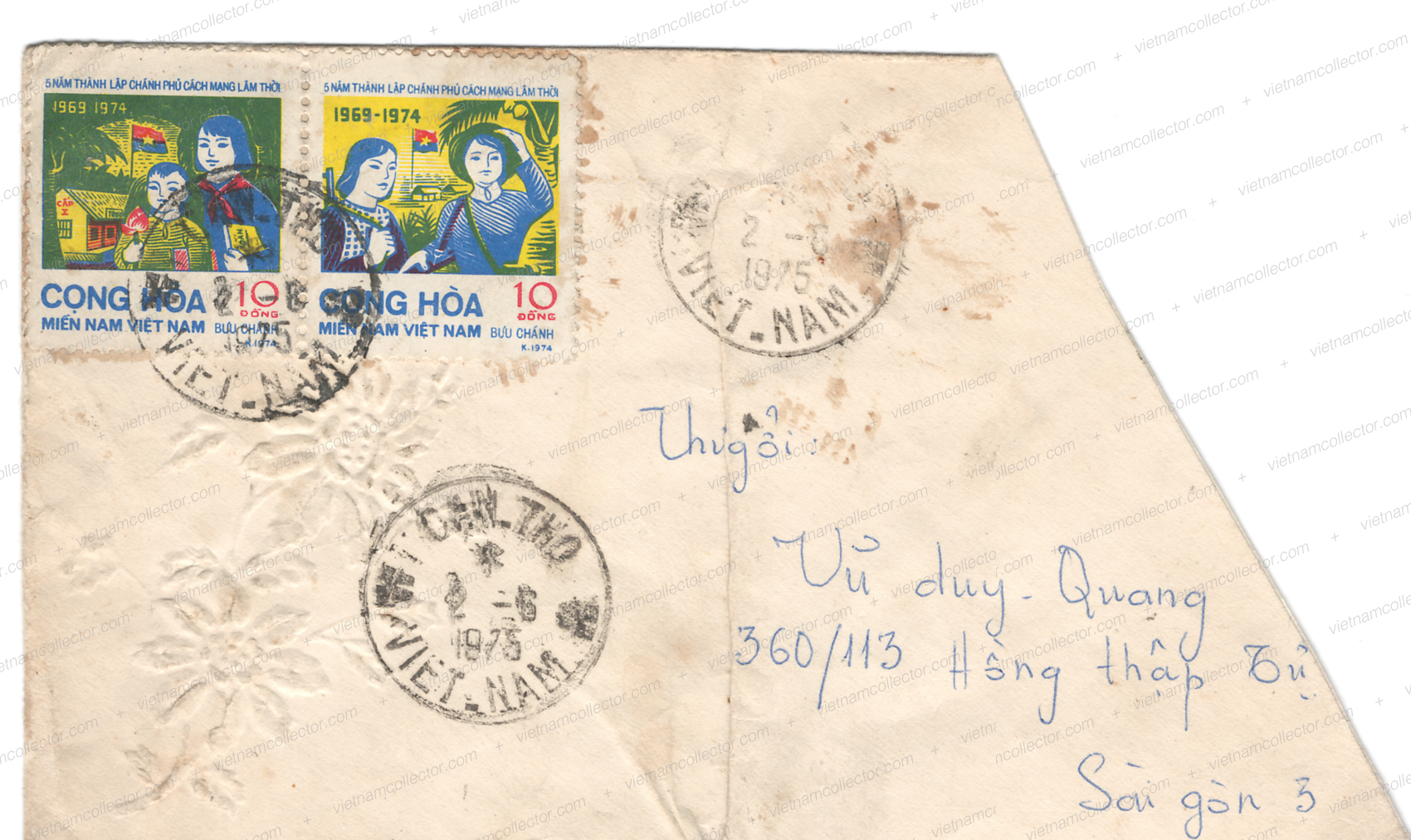 Mixed currency franking of NLF Dong stamps (310D) and unified currency stamps (18xu) on an air mail letter sent from Colon to the United States in 1976. The letter was cancelled with the special cancel produced for the national election of the new assembly. The NLF Dong was devalued by 500:1 on April 1st, 1976 which meant the two stamps in old currency were only worth 0.62D in new currency. Together with the two stamps in new currency the overall postage hence amounted to 0.80 new Dong.
Mixed currency franking of NLF Dong stamps (310D) and unified currency stamps (18xu) on an air mail letter sent from Colon to the United States in 1976. The letter was cancelled with the special cancel produced for the national election of the new assembly. The NLF Dong was devalued by 500:1 on April 1st, 1976 which meant the two stamps in old currency were only worth 0.62D in new currency. Together with the two stamps in new currency the overall postage hence amounted to 0.80 new Dong.
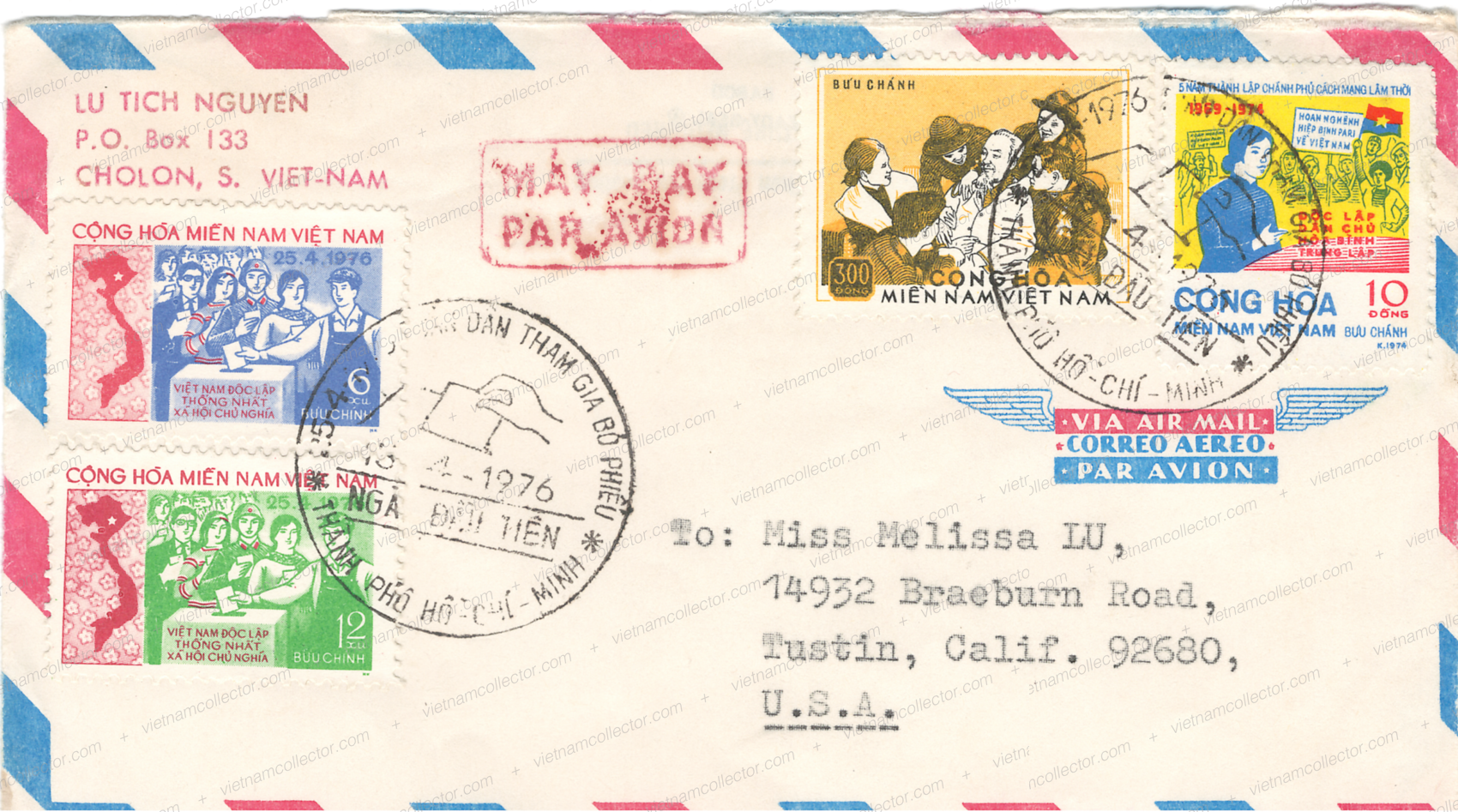
As per Ta Phi Long’s book “Some Features of postal History in the Period of Revolutionary South Vietnam” these stamps were overprinted with 15D (small number in black), 15D (large number in red and black) 30D (small number in red and black) and 30D (large number in red). All genuine letters known so far are from dates after the end of the war (April 30th, 1975). As per Ta Phi Long these stamps were used in Quy Non, Binh Dinh, Quang Tri, Da Nang, Quang Ngai, Nha Trang and Quang Ngai.
Here is a mint strip of five with the genuine small 15D overprint in black.
Detailed scan of the genuine overprint
Overprint errors do occur. Here is a stamp where the first overprint was struck rather light and hence a second overprint was added on top.
Here is a strip of five with the genuine large 15D overprint in black.
Detail of the genuine large 15D overprint.
Of course there are also counterfeit overprints. Here is a strip of five with a forged large 15D overprint in black.
Detail of the forged large 15D overprint in black.
Sometimes forgers create fake inverted overprints as is shown here.
Registration No. 200014





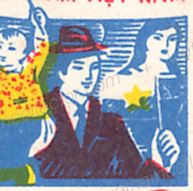
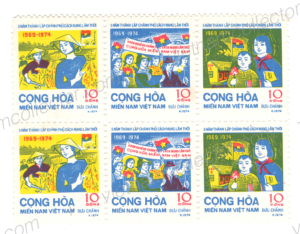



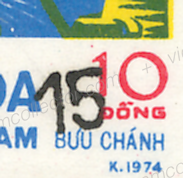
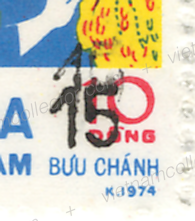

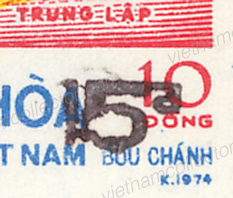

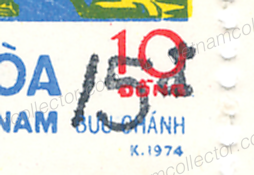
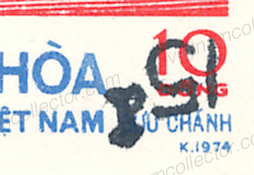
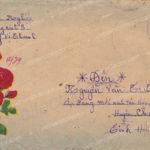
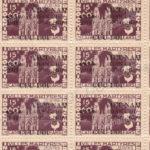
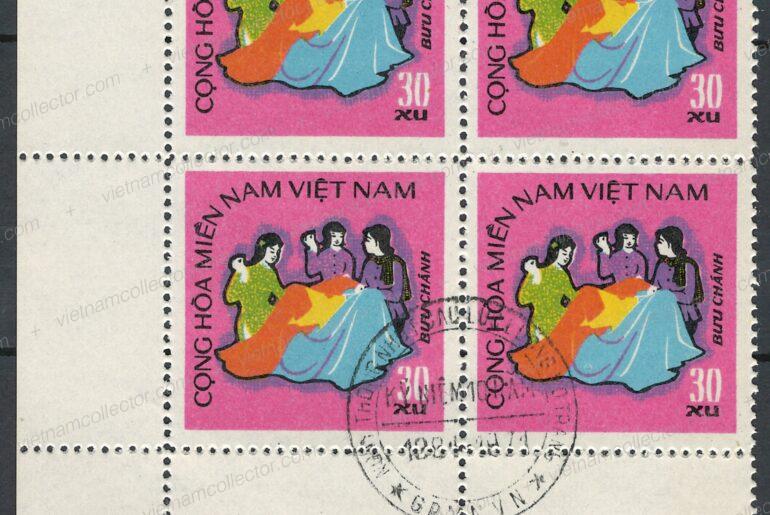
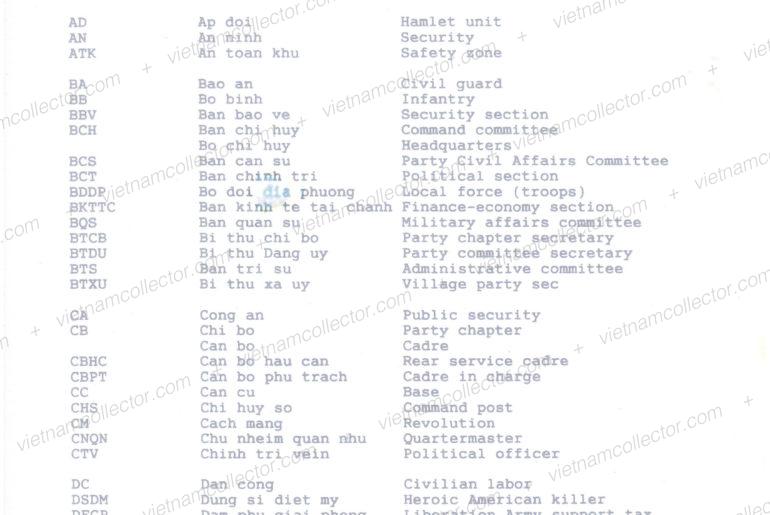
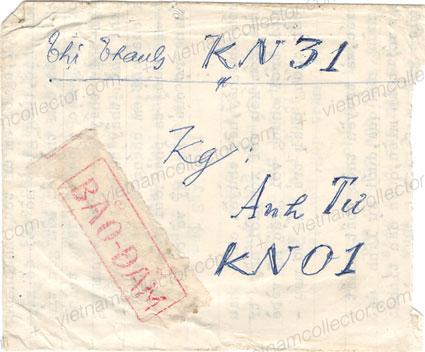
Comments are closed.